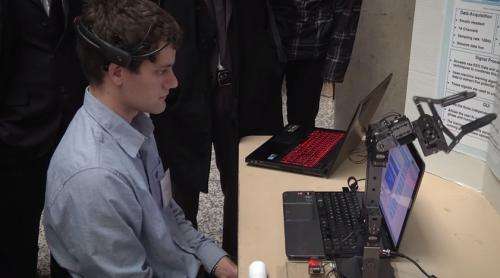May 17, 2014 weblog
Toronto team's robotic arm control is all in the mind

This week's attention-getting version of a mind-controlled robotic device comes in the form of an Emotiv EPOC BCI headset controlling a robotic arm with a system smart enough to move the arm using simple movements such as a clenched jaw or wink of the eye. University of Toronto student Ryan Mintz and his team connected an Emotiv EPOC BCI headset to a robotic arm, which responded to the brainwaves captured by the headset. Emotiv EPOC is a high resolution, multi-channel, wireless neuroheadset. The EPOC uses a set of 14 sensors and two references to tune into electric signals produced by the brain to detect a user's thoughts, feelings and expressions in realtime. The EPOC connects wirelessly to most computers. The team designed the system with the hope of contributing to technologies applied to prosthetic limbs.
A Thursday report in Neurogadget made the point that the university students were hardly the first to venture into the arena of mind-controlled robotic arms but that there was always room for research efforts nonetheless. "Although high-end scientific research projects in the field have already led to much more advanced results…it is definitely a good thing that more and more student projects involve the use of BCI."
BCI stands for brain-computer interface, referring to the direct communication path between the brain and external device. BCI research and development has since focused primarily on neuroprosthetics applications that aim at restoring damaged hearing, sight and movement. effort shows that quadriplegics and others with little body control could eventually claim some independence.
The U.S. Food and Drug Administration (FDA) on May 9 announced it was allowing marketing of the DEKA Arm System, the first prosthetic arm that can perform multiple, simultaneous powered movements controlled by electrical signals from electromyogram (EMG) electrodes. EMG electrodes detect electrical activity caused by the contraction of muscles close to where the prosthesis is attached. The electrodes send the signals to a computer processor in the prosthesis that translates them to a movement or movements. The DEKA Arm System can be configured for people with limb loss at the shoulder joint, mid-upper arm, or mid-lower arm.
In the university video, Mintz credited Berj L. Bardakjian, a biomedical engineering professor, for being helpful to the team in the process of their work. The professor's research interests include neural engineering, biological and artificial neural networks, electrical rhythmic activities of the brain, prediction and control of epileptic seizures, modeling of nonlinear physiological systems, biological clocks, and signal processing of nonstationary electrical signals from the brain.
© 2014 Tech Xplore

















